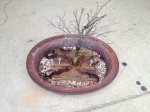hi there and welcome,
you can definitively use an elm to try a ROR, I am actually doing one since last year
View attachment 113917
this picture was taken last year, when I potted it, since I removed the wire and the raffia have decayed.
also the rock isn't the good one so I'll have to re-pot it on the right one but that's fine for the moment at it gives time for the roots to grow around a rock anyway (and this rock is a smooth quartz, it will be easy to slip it out without damaging the roots).
also this was my first ROR attempt, it won't be on the cover of next month 'Bonsai addicts magazine'.
although it looks much better than on the above picture now

I am not and expert in ROR but the principle is: first you pick a rock (if it can be the one the tree will actually be on it's better

) you bare root your tree and you dispose the roots on the rock then you tie them to it (raffia is the best because you can firmly attach the roots without damaging them and then it decay with time in the soil which is fine because your roots are maintain by the the soil and don't need raffia anymore).
Then normally you apply peat-muck on the surface of the roots tied to the rock in order to make a sort of cast around the roots.
I never did that because I still don't understand how to make the peat muck so I just put the tree attached to the rock in a pot and I buried all or almost all the rock and roots and let them grow like that.
For the moment I didn't reach the step where you uncover the roots progressively once they have develop around the rock.
I hope that help

PS: otherwise I think any tree could be use as a ROR, but elm is definitively a good choice because they are really tough and forgive a lot of rookie mistakes., that's why the one above is still alive








